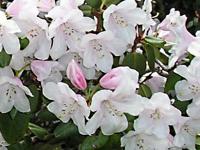How to Grow Rhododendrons & Azaleas
 Rhododendrons are a large group of plants that thrive on acid soil
Rhododendrons are a large group of plants that thrive on acid soilLearn the basics of how to grow and care for Rhododendrons and Azaleas in your garden.
The Genus Rhododendron contains hundreds of species of evergreen and deciduous trees and shrubs, many found growing naturally all around the world. From these naturally occurring species many cultivars have been bred to attract the gardening community. Because of the vast number of Rhododendrons, there are species and cultivars to cover almost every month of the year in terms of flowering. However, in the UK most of the varieties available flower during the spring and early summer.
Soil Requirements

The Genus Rhododendron also includes the group of plants most people know as Azaleas. All Rhododendrons belong in a group of plants labelled calcifuge or ericaceous meaning that they do not like to grow in alkaline soil and much prefer an acidic soil with a low pH value. Other calcifuge plants include Camellias, Ericas, Blueberries and Pieris.
Not everyone of course has a garden full of acidic soil for growing Rhodendrons and other calcifuge plants. You can assess the suitability of the soil in your garden by using a soil testing kit.
Many gardeners sucessfully grow Rhododendrons in containers or raised beds. They do this so they can manage the soil in which the Rhododendrons are growing in. When cultivating Rhododendrons in this way it is important to use a good quality soil based ericaceous compost. Such a compost will be well drained yet rich and nutritious and it will have a pH value between 4.5 and 5.5.
When you do grow Rhododendrons in a pot or raised bed, eventually the compost will become devoid of nutrition and will need feeding. Add an ericaceous plant food to the watering can to maintain the long term good health of the plants.
Planting

When planting a Rhododendron make sure that you don't plant it too deep, all rhododendrons like to have their roots near the soil surface and planting too deep may result in plant death.
Location
Most Rhododendrons prefer to grow in light shade although some of the smaller types are quite happy in full sun providing the soil is reliably moist. This is all to do with where they are found growing naturally in the wild. The larger leaved varieties are often found growing on the woodland edge where there is light shade. Some of the smaller varieties are found growing in the wild in alpine regions where they grow in full sun but they have an almost constant supply of water from snow melt.
Watering
When it comes to watering, it's also important to know the pH value of the water, or just collect rainwater in a water butt to avoid any problems; mains tap water can often be too hard with a high pH value which over time can have a detrimental impact on a Rhododendron.
Pruning
There isn't really any need to prune a Rhododendron unless you wish to attain a desired shape. You can also remove any branches that appear dead or are crossing or rubbing against each other.
Providing you follow a few basic rules, Rhododendrons are really not that difficult to grow. The flowers are very attractive and often fragrant and the often evergreen foliage provides all year round structure and interest in the garden.
Filed under Shrubs.

